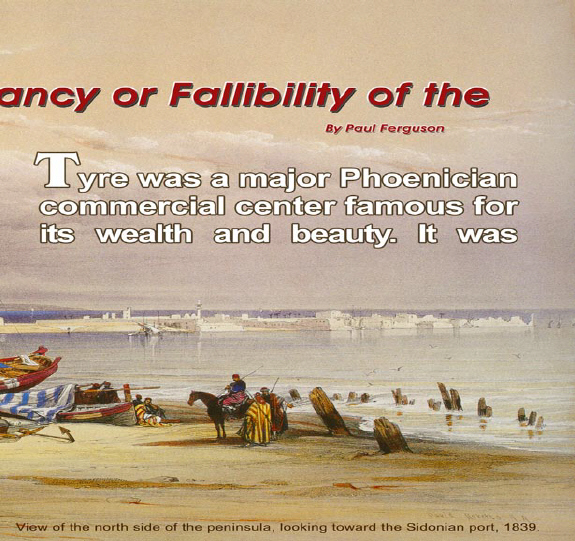Ezekiel 26:1-14 A Proof text for Inerrancy or Fallibility of the Old Testament? -- By: Paul Ferguson
Journal: Bible and Spade (Second Run)
Volume: BSPADE 19:2 (Spring 2006)
Article: Ezekiel 26:1-14 A Proof text for Inerrancy or Fallibility of the Old Testament?
Author: Paul Ferguson
BSpade 19:2 (Spring 2006) p. 49
Ezekiel 26:1-14
A Proof text for Inerrancy or Fallibility of the Old Testament?


BSpade 19:2 (Spring 2006) p. 50
Tyre was a major Phonician commercial center famous for its wealth and beauty. It was located on two sandstone reefs about 1.2 mi (2 km) off the coast of Lebanon. According to Herodotus, King Hiram (ca. 969–936 BC) joined the two reefs with land fill, enlarging the city to about 40 acres (16ha). In succeeding reigns, further enlargment allowed the creation of ports on the northern and southern sides of the island. The island city was essentially a commercial and religious center dependent on food and water supplies from its sister city, “Old Tyre,” which stood amid rich and well-watered agricultural land on the mainland.
From his exile in Babylon, Ezekiel prophesied against Tyre in the early sixth century BC. At this time, Tyre had reached the zenith of its commercial prosperity and was the cosmopolitan center of the ancient Near East. Ezekiel 26 and 28 contain predictions of God’s coming judgment against the city and its king, while chapter 27 is a lament in which Ezekiel graphically describes the commercial activities and great prosperity of the city.1
This article seeks to give Ezekiel 26:1–14 a close reading. Special emphasis will be given to its literary structure and the use of metaphors. The history of Tyre will be examined in the light of archaeology and ancient records. It is our contention that when the passage is exegeted carefully and properly, these verses are excellent witnesses to the divine inspiration of the Bible. More liberal Biblical scholars, however, have seized upon these verses as a parade example of the fallibility of Biblical prophecy. Robert P. Carroll has even written an entire book on failed prophecies in the OT (1979).
Liberals are virtually unanimous on the following interpretation:
1. Ezekiel 26:1–14 predicts that Nebuchadnezzar would capture Tyre and get rich from it.
2. Ezekiel 29:17–20 is an apology by the prophet for being wrong. Nebuchadnezzar is offered the land of Egypt as a consolation prize for this “disappointing, false prophecy.” Ezekiel was, they say, not in the slightest bit bothered by being wrong.
...
Click here to subscribe
